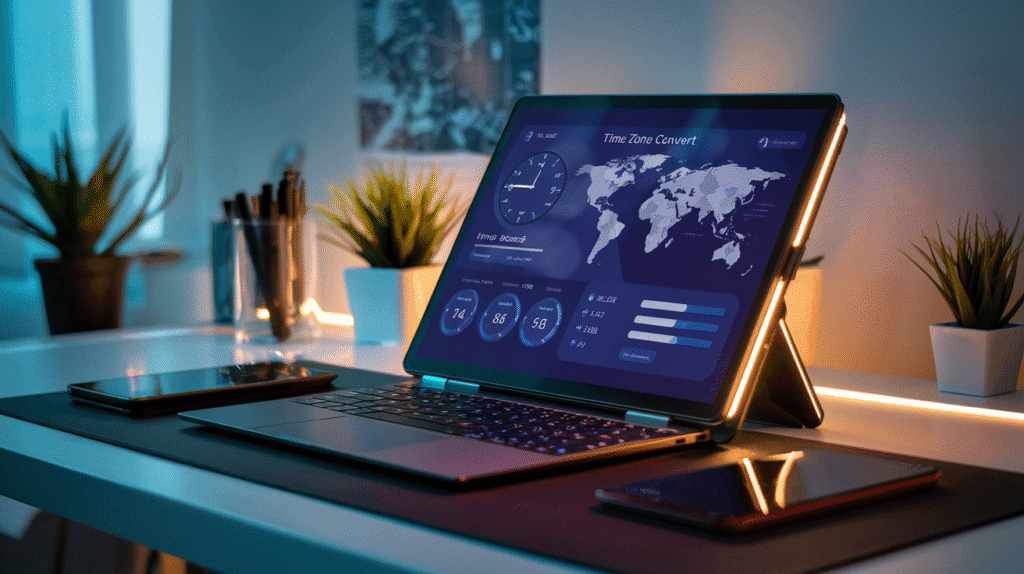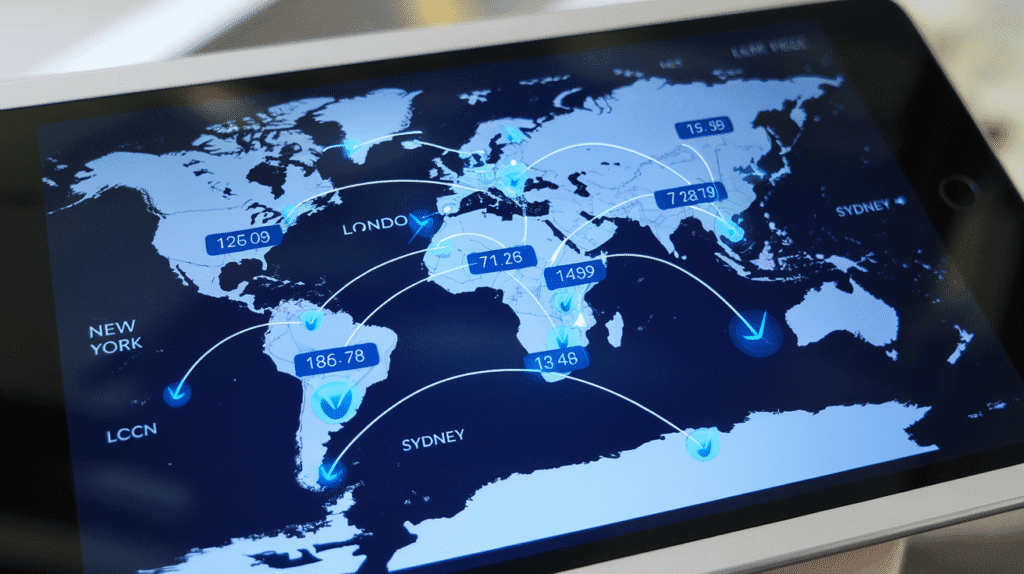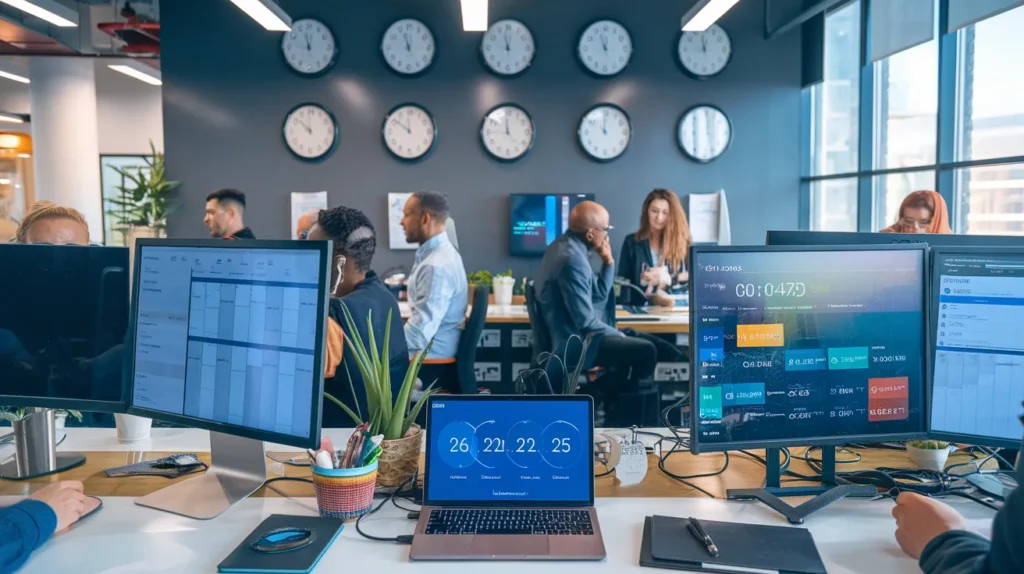Time Zone Converter
Have you ever missed an important international call because you miscalculated the time difference? Or perhaps scheduled a team meeting only to find half your colleagues unable to attend because it was 3 AM in their location? In today’s interconnected global landscape, navigating the complex web of time zones has become an essential skill for professionals, travelers, and anyone communicating across borders. The frustration of mental calculations and the embarrassment of scheduling errors can be both professionally damaging and personally stressful.
Time zone converters have emerged as the critical solution to this universal challenge. Tools like World Time Buddy (WTB) have revolutionized how we manage global time differences, offering intuitive interfaces that instantly display multiple time zones side by side. Whether you’re coordinating between New York and London, California and Hawaii, or any points across the globe, these digital assistants eliminate the confusion of Daylight Saving Time changes and regional time variations. ⏰ 🌎 No longer must users rely on complex mental math or outdated conversion charts to find that perfect meeting time.
In this comprehensive guide, we’ll explore the essential features of modern time zone conversion tools, examine their practical applications in business and personal settings, walk through common conversion scenarios, and discover how these powerful tools can dramatically enhance your productivity in our increasingly borderless world.
Table of Contents
Understanding Time Zone Converters: Your Global Time Management Solution

What Time Zone Converters Are and Why They’re Essential for Global Communication
The digital age has turned the world into a global village where someone in Tokyo can hop on a call with colleagues in New York without leaving their desk. But that convenience comes with a challenge: coordinating across time zones. Time zone converters tackle this problem head-on.
Time zone converters are digital tools that translate times between different regions of the world. These handy utilities save people from the mental gymnastics of calculating what “3 PM Eastern Time” means for someone in Paris or Sydney.
For businesses operating globally, these tools aren’t just convenient—they’re mission-critical. Missing a client call because of a time zone miscalculation can cost deals and damage relationships. Remote teams rely on these converters to schedule meetings when team members are actually awake and working.
Travelers benefit tremendously too. Nothing ruins a vacation faster than missing a flight because someone confused GMT with local time. Modern converters help avoid these painful mistakes.
The need for these tools has grown exponentially with remote work trends. A team might now span five continents, making “quick sync-ups” nearly impossible without proper time translation tools.
Evolution of Time Zone Tools from Basic Calculators to Comprehensive Solutions
Time zone tools have come a long way from their humble beginnings. The earliest digital versions were simple calculators—enter a time in one zone, get the equivalent in another. Practical, but limited.
These rudimentary tools have evolved into sophisticated platforms offering rich features:
| Era | Tool Capabilities |
|---|---|
| Early 2000s | Basic time conversion between major cities |
| 2010s | Multiple time zone display, calendar integration |
| 2020s | AI scheduling, team availability views, meeting optimizer |
Modern converters don’t just convert time—they recommend optimal meeting slots based on working hours across teams. They integrate with calendars, automatically adjusting events when team members view them in their local time.
Visual interfaces have transformed too. Early tools displayed text-only outputs, while today’s versions offer color-coded world maps showing day/night cycles in real-time.
The introduction of mobile apps brought these tools into everyone’s pocket. Now, checking if it’s too late to call Australia is as simple as tapping an app.
How Time Zone Converters Account for Daylight Saving Time (DST) Changes
Global time management becomes even more complex with the addition of Daylight Saving Time. Different countries start and end DST on different dates—if they observe it at all.
Advanced time zone converters handle this complexity invisibly. They maintain databases of DST rules worldwide, automatically adjusting calculations based on the specific date being converted.
These tools understand that Melbourne and Sydney might be on different times during certain weeks of the year. They know that Arizona doesn’t follow DST while the rest of its time zone does. They recognize that Brazil’s DST schedule doesn’t align with Europe’s.
Without these smart tools, people would need encyclopedic knowledge of global DST policies. The potential for errors would be enormous.
Time zone databases require constant updates as governments frequently change DST policies with little notice. Top-tier converters pull these updates automatically, ensuring accuracy even when local regulations shift unexpectedly.
For recurring meetings, this feature proves particularly valuable. A meeting scheduled months in advance will still show the correct local time even if DST status changes between scheduling and the actual event.
Key Features of Modern Time Zone Conversion Tools

Gone are the days of manual calculations and confusing time zone math. Modern time zone converters now display multiple time zones side by side in real-time. This feature is a game-changer for teams spread across the globe.
Users can view what time it is in New York, London, Tokyo, and Sydney all at once. The display updates automatically, so there’s no need to refresh the page. Many tools use color coding to highlight business hours or indicate day/night, making it easier to spot optimal meeting times at a glance.
The best converters even account for Daylight Saving Time changes automatically. No more wondering if a particular region has switched their clocks forward or back. The system handles all those tricky details behind the scenes.
Customizable interfaces with location addition and removal options
The ability to personalize a time zone converter makes all the difference. Top-tier conversion tools now offer drag-and-drop interfaces where users can add or remove locations in seconds.
Many platforms remember your frequently used locations, saving precious setup time. Some even offer smart location grouping – perfect for organizing time zones by project team or client region.
The visual layouts are getting better too. Users can choose between list views, clock faces, or map-based displays depending on their preferences. Many tools now include dark mode options and accessibility features to accommodate different needs.
Time conversion capabilities for precise scheduling
Scheduling across time zones isn’t just about knowing what time it is now – it’s about planning for the future. Modern conversion tools excel at this crucial task.
Advanced converters allow users to set a specific date and time in one location and instantly see the corresponding times worldwide. This feature is invaluable for planning international webinars, product launches, or important calls.
Some tools go further by offering “best time to meet” suggestions based on working hours in each location. They analyze the overlap in business hours and highlight optimal meeting windows automatically.
Widgets for websites and desktop integration
The most useful time zone tools extend beyond their own websites. Many now offer embeddable widgets that can be added to any website or blog. These widgets inherit the site’s styling while providing live time zone information.
Desktop integration has also become standard. Quick-access system tray tools show multiple time zones without opening a browser. Features for calendar integration automatically show event times in the recipient’s localized time zone.
For developers, API access allows time zone functionality to be built directly into custom applications. This opens up possibilities for time-aware scheduling assistants and other specialized tools.
Practical Applications for Time Zone Converters

A. Planning international business meetings and conference calls
The global business landscape never sleeps. Companies constantly collaborate across continents, making time zone converters indispensable tools for scheduling meetings without headaches.
Consider a scenario where a marketing team needs to connect stakeholders from New York, London, and Singapore. Without a time zone converter, someone inevitably ends up joining at 3 AM or missing the meeting entirely. Time zone converters eliminate this confusion by showing when 2 PM Eastern Time translates to 7 PM in London and 2 AM in Singapore.
Many professionals now integrate these tools directly into their workflow:
- Calendar applications with built-in conversion features
- Meeting scheduling platforms that show various time zones at once. Dedicated platforms for scheduling meetings that show numerous time zones at the same time.
- Browser extensions that convert times on web pages with a single click
The real power comes from visualizing overlap in working hours. Teams can instantly identify “golden hours” when everyone’s workday overlaps, typically offering a 2-3 hour window for important discussions.
B. Coordinating with remote teams across different regions
The popularity of remote work has soared, with teams dispersed across diverse nations and time zones. This global distribution creates both opportunities and challenges for coordination.
Time zone converters serve as the backbone for remote team management. Project managers use these tools to:
- Set up staggered working schedules that ensure 24-hour coverage
- Create color-coded team availability charts showing when team members are online
- Establish clear handoff procedures between regions
Some companies have developed creative solutions around time differences. “Follow-the-sun” development models, where work passes between teams in different time zones, allow for continuous progress without requiring anyone to work odd hours.
Intelligent teams use time zone converters proactively, not just as a reaction. They build their entire collaboration strategy around time zone awareness, with asynchronous communication as the default and synchronous meetings reserved for critical discussions during overlap hours.
C. Scheduling global broadcasts and events
Media companies, sports organizations, and global brands face unique challenges when broadcasting to international audiences. Time zone converters play a crucial role in planning worldwide events.
Take major sporting events like the Olympics or World Cup. Broadcasters must coordinate:
- Live coverage across multiple time zones
- Primetime replays tailored to regional audiences
- Digital content release schedules
- Advertising insertions timed for maximum regional impact
Global product launches have similar requirements. When Apple reveals a new iPhone, marketing teams ensure the announcement happens at optimal times for key markets while maintaining the excitement of a simultaneous global release.
Virtual events have their own complexity. Conference organizers often create “time zone tracks” that repeat key sessions at different times to accommodate global attendees. Some even run 24-hour events with programming rotating through regional focuses as the day progresses.
D. Optimizing travel planning across time zones
Jet lag isn’t just about feeling tired – it’s a productivity killer that savvy travelers work hard to minimize. Time zone converters help travelers plan strategically:
- Calculating exact flight durations accounting for time changes
- Planning arrival times to maximize adjustment to new time zones
- Scheduling important meetings during biological peak performance hours
- Managing medication timing during international travel
Business travelers often use specialized apps that combine time zone conversion with jet lag management features. These tools provide personalized advice on when to seek sunlight, when to sleep, and even when to consume caffeine for optimal adjustment.
Flight booking strategies also benefit from time zone awareness. The savvy traveler knows that eastbound flights (which “lose” time) are typically harder on the body than westbound ones. Some even book longer layovers strategically to begin adapting to destination time zones before arrival.
Popular Time Zone Conversion Scenarios

A. Major business hubs: New York-London, Tokyo-San Francisco conversions
Time zone juggling becomes a daily ritual for professionals working across major business hubs. The New York-London route stands as one of the most trafficked business corridors, with a 5-hour difference (Eastern Time to GMT). This means when Wall Street opens at 9:30 AM, London traders are already heading to lunch at 2:30 PM. The sweet spot for meetings? Early New York mornings and late London afternoons, typically between 8 AM-10 AM ET (1 PM-3 PM GMT).
The Tokyo-San Francisco connection presents even greater challenges with a 16-hour difference (or 17 during DST). When it’s 9 AM Monday in San Francisco, Tokyo is already experiencing 2 AM Tuesday. Tech companies often schedule their cross-Pacific meetings during what’s called the “overlap window” – usually San Francisco evenings and Tokyo mornings.
B. Regional time differences: California-Hawaii, East Coast-West Coast
Even within the United States, time zone differences can complicate coordination. The East Coast-West Coast gap of 3 hours means New Yorkers are finishing their lunch meetings while Los Angelenos are just starting their day. This creates a compressed collaboration window of roughly 12 PM-5 PM Eastern, when both coasts are in business hours.
The California-Hawaii corridor presents its own quirks with a 2-3 hour difference depending on Daylight Saving Time (which Hawaii doesn’t observe). Mainlanders calling Hawaii at what seems like a reasonable 4 PM Pacific might disrupt someone’s early 1 PM lunch. Hawaii residents often adjust their schedules earlier to maximize mainland communication time.
C. Cross-continental planning: Europe-Asia, North America-Australia
Planning events across continents requires serious time zone strategy. The Europe-Asia connection spans multiple time zones, with London and Beijing separated by 8 hours. A 9 AM meeting in Berlin means a 3 PM start in Singapore. Many Europe-Asia businesses operate on a “follow-the-sun” model, where work transitions between offices as each region’s workday ends.
The North America-Australia gap represents one of the toughest global coordination challenges, with virtually no standard business hour overlap.Sydney operates approximately 14-16 hours ahead of New York, depending on which seasonal time change we are observing. Teams often resort to alternating “pain meetings” where one group takes a very early or very late call. Smart companies implement asynchronous collaboration tools to minimize these odd-hour meetings.
Enhancing Productivity with Time Zone Tools

A. Mobile applications for on-the-go time management
Time zone management isn’t just for office desks anymore. Mobile apps have revolutionized how professionals handle international scheduling while traveling or working remotely. Apps like World Time Buddy, Time Buddy, and Timezone.io offer intuitive interfaces that make checking multiple time zones as simple as glancing at a phone.
The best mobile time zone tools sync across devices, ensuring that whatever changes someone makes on their desktop appear instantly on their phone. Many users particularly appreciate apps that include widgets, allowing them to see critical time zone information without even opening the app—perfect for that quick check before making an international call from the coffee shop.
B. Saving favorite locations and frequently used time zone combinations
Nobody wants to repeatedly enter “Tokyo, London, and New York” every time they need to schedule a call. That’s why saving favorite locations has become such a game-changer for regular users of time zone converters.
Most advanced tools now allow users to create custom groups or presets of frequently referenced locations. For example, a product manager working with teams in multiple countries might create a “Product Team” preset that instantly displays working hours across Singapore, San Francisco, and Berlin. These saved combinations dramatically reduce setup time and prevent embarrassing scheduling errors.
C. Calendar integration for seamless scheduling
The tools that help with time zones take the calendar from being merely useful to being absolutely essential. Timothy R. Winters When a time zone converter connects directly with Outlook, Google Calendar, or iCal, the scheduling process becomes nearly foolproof.
Modern tools offer features like:
| Feature | Benefit |
|---|---|
| Automatic time translation | Events show in local time for all participants |
| Availability highlighting | Shows when everyone is working (no more 3AM meetings) |
| Meeting suggestions | AI-powered recommendations for optimal meeting times |
| Event creation | Create calendar invites directly from the converter |
These integrations eliminate the mental math and confusion that typically accompany international scheduling.
D. Sharing and collaboration features for team coordination
The days of emailing screenshots of time converters are thankfully behind us. Today’s time zone tools include sophisticated sharing options designed specifically for team environments.
Teams can now create shared workspaces where everyone sees the same time zone information. Some platforms allow managers to set team working hours, making it instantly visible when colleagues in other countries are available. Shared links with embedded time zone information ensure everyone arrives at meetings at the correct time, regardless of where they’re located.
The most powerful collaboration features include real-time updates. When someone changes a meeting time, everyone sees the change in their local time zone immediately. This synchronization has proven invaluable for distributed teams managing complex project schedules across multiple continents.

Conclusion
Time zone converters have become essential tools in our increasingly globalized world. From World Time Buddy’s comprehensive features to simpler conversion tools that account for Daylight Saving Time changes, these solutions offer invaluable assistance for international business communications, remote team collaboration, and global event planning. The ability to instantly compare times across locations like New York and London or California and Hawaii empowers users to find optimal meeting times without the mental gymnastics previously required.
As global connections continue to expand, adopting a reliable time zone conversion tool is no longer optional but necessary for efficient time management. Whether coordinating international travel, scheduling important conference calls, or simply staying connected with friends and family abroad, these tools eliminate confusion and prevent missed opportunities. By incorporating time zone converters into daily workflows, professionals and individuals alike can navigate the complexities of global time differences with confidence and precision, ultimately enhancing productivity and fostering seamless global communication.

